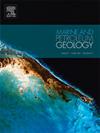Reactivation of abandoned oilfields for cleaner energy generation: Two-dimensional modelling of lateral stratigraphic variations
IF 3.7
2区 地球科学
Q1 GEOSCIENCES, MULTIDISCIPLINARY
引用次数: 0
Abstract
Abandoned oil fields can be stimulated by the injection of air to produce energy by way of the direct use of the heat and pressure generated by in-situ oxidation of oil, or thermogenesis, in enhanced geothermal systems. This paper will assist in the selection of potential fields for reactivation by showing the potential enthalpy generation of realistic reservoirs based on North Sea analogues and how natural reservoir quality variation will affect the success of any potential applications. Previously, air injection has primarily been used as an enhanced oil recovery technique, although it has been plagued with failures now attributed to poor reservoir selection and project design. We propose that an insufficient understanding of the geology of the reservoir is a key reason that so many air injection projects have failed. With the aid of computer numerical modelling, we aim to understand how reservoir porosity, permeability, and petrophysical heterogeneity affect the process. Here we have used two-dimensional, map-view models to evaluate a selection of homogeneous and heterogeneous reservoir architectures broadly based on North Sea oil fields. Our models demonstrate that the combination of degree of random heterogeneity and architecture of facies-controlled heterogeneities play more significant roles in the temperature, velocity, and stability of the reaction front across the reservoir than either average porosity or permeability. The strong influence of reservoir petrophysical heterogeneity on the effectiveness of the air injection process highlights the need to fully understand how such reservoir properties are distributed both randomly and via predictable facies-controls, and, in turn, how these are further influenced by reservoir-scale geological architecture.
求助全文
约1分钟内获得全文
求助全文
来源期刊

Marine and Petroleum Geology
地学-地球科学综合
CiteScore
8.80
自引率
14.30%
发文量
475
审稿时长
63 days
期刊介绍:
Marine and Petroleum Geology is the pre-eminent international forum for the exchange of multidisciplinary concepts, interpretations and techniques for all concerned with marine and petroleum geology in industry, government and academia. Rapid bimonthly publication allows early communications of papers or short communications to the geoscience community.
Marine and Petroleum Geology is essential reading for geologists, geophysicists and explorationists in industry, government and academia working in the following areas: marine geology; basin analysis and evaluation; organic geochemistry; reserve/resource estimation; seismic stratigraphy; thermal models of basic evolution; sedimentary geology; continental margins; geophysical interpretation; structural geology/tectonics; formation evaluation techniques; well logging.
 求助内容:
求助内容: 应助结果提醒方式:
应助结果提醒方式:


